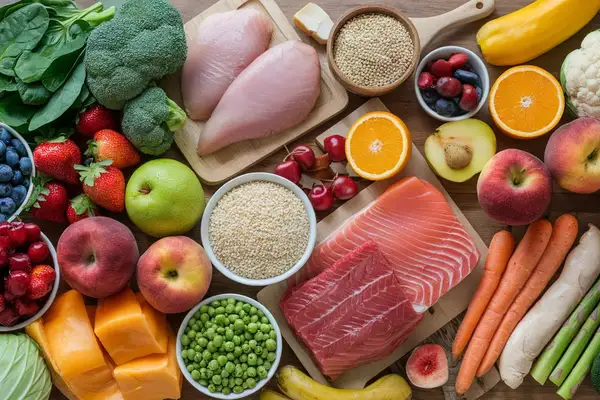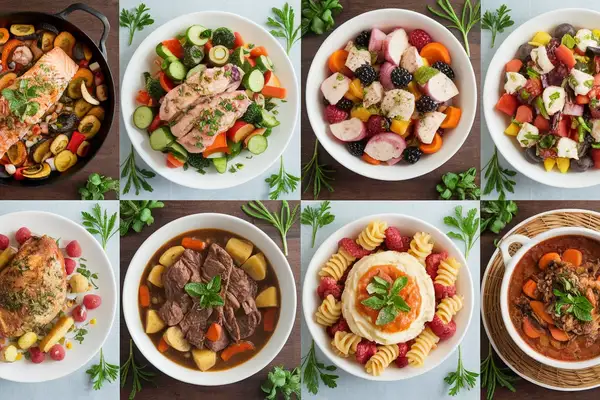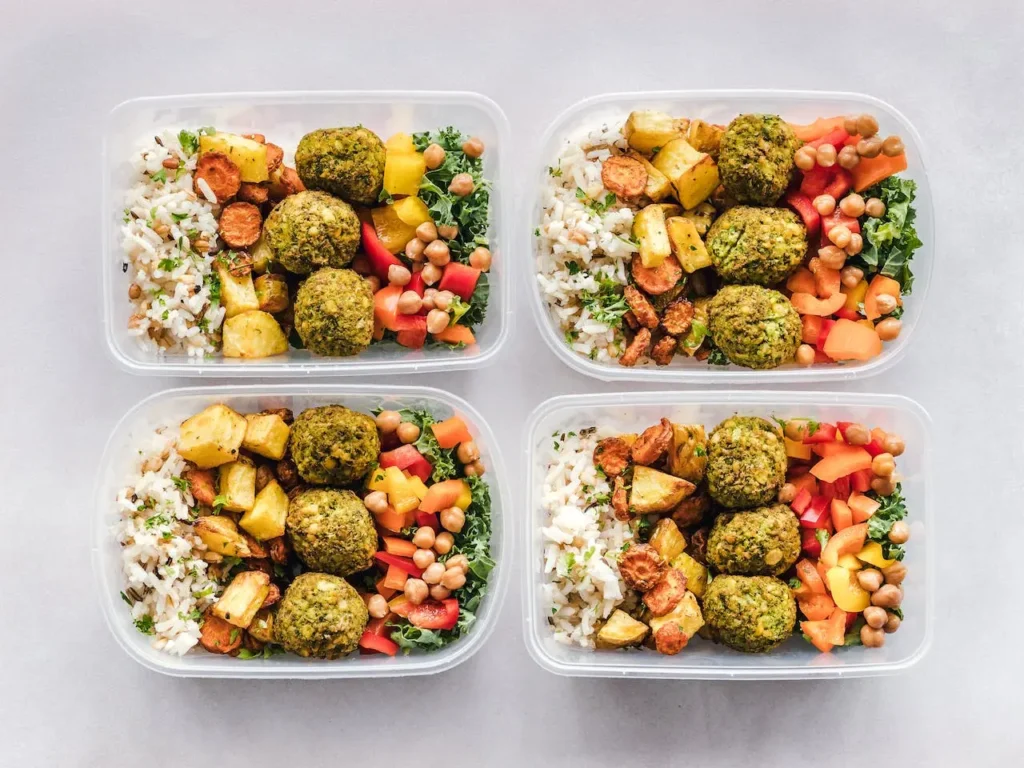Healthy 7-Day Diet to Lower Triglycerides
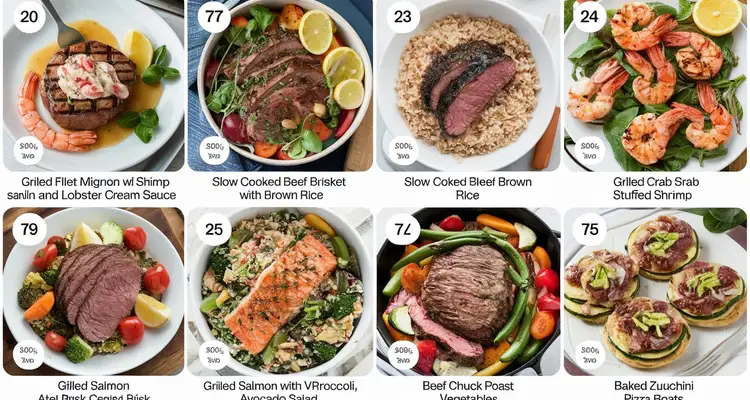
What is Triglycerides?
This post may contain affiliate links, meaning I may earn a commission if you make a purchase, at no extra cost to you. I only recommend products I trust. Thank you for your support.
Triglycerides are a type of fat found in your blood. When you eat, your body converts any calories it doesn’t need into triglycerides, which are stored in your fat cells.
High triglycerides can be a warning sign for heart disease, but with the right diet, you can take control of your health naturally.
A triglycerides lowering diet is a heart‑healthy eating pattern specifically designed to reduce blood levels of triglycerides, the most common form of fat in your blood.
Elevated triglycerides (≥150 mg/dL) increase risk for cardiovascular disease, pancreatitis, and metabolic syndrome, but lifestyle and dietary changes can have a dramatic impact on lowering them.
This 7-day diet to lower triglycerides is packed with delicious, heart-healthy foods that will help you reduce those numbers and improve your overall well-being.
So let’s dive into a healthy triglycerides lowering diet that focuses on foods to lower triglycerides, ensuring you enjoy every meal without feeling deprived.
7-Day Diet to Lower Triglycerides
This 7-day diet to lower triglycerides is rich in fiber, omega‑3s and unsaturated fats, and low in added sugars and refined carbs to help bring your cholesterol levels to the healthy range of <150 mg/dL.
This triglycerides lowering diet features a balanced variety of nutrient-dense high fiber meals designed to support heart health and lower triglyceride levels.
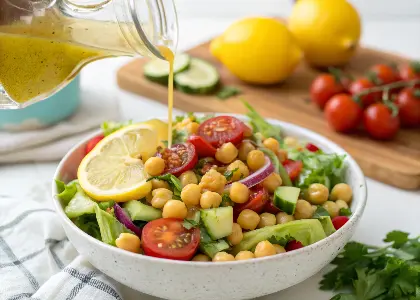
Day 1
Breakfast:
- Steel‑cut oats with berries & flaxseed: Cook ½ cup steel‑cut oats in 1 cup water; stir in ½ cup mixed berries and 1 tbsp ground flaxseed. (½ cup steel‑cut oats, 1 cup water, ½ cup berries, 1 tbsp flaxseed)
Lunch:
- Chickpea‑quinoa salad: Toss ½ cup cooked quinoa, ½ cup chickpeas, 1 cup chopped cucumber, 1 cup cherry tomatoes, 1 tbsp olive oil and lemon juice; garnish with parsley. (½ cup quinoa, ½ cup chickpeas, 1 tsp olive oil, veggies)
Dinner:
- Grilled salmon with barley & Brussels sprouts: Grill 4 oz salmon; roast 1 cup halved Brussels sprouts; serve with ½ cup cooked barley. (4 oz salmon, ½ cup barley, 1 cup sprouts)
Snacks:
- Apple slices with almond butter: Slice 1 apple; pair with 2 tbsp almond butter.
- Raw walnuts & carrot sticks: 1 oz walnuts with 1 cup carrot sticks.
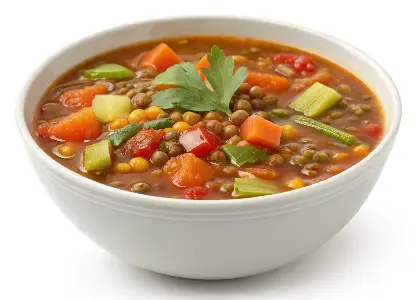
Day 2
Breakfast:
- Buckwheat pancakes with blueberries: Whisk ½ cup buckwheat flour, 1 egg, ½ cup milk; cook and top with ½ cup blueberries. (½ cup flour, 1 egg, ½ cup milk, ½ cup berries)
Lunch:
- Lentil‑vegetable soup: Simmer 1 cup lentils with 1 cup mixed vegetables and broth. (1 cup lentils, mixed veggies)
Dinner:
- Turkey & black bean stuffed peppers: Fill 2 bell‑pepper halves with 3 oz ground turkey, ½ cup black beans, ¼ cup brown rice and spices; bake until tender. (2 peppers, 3 oz turkey, ½ cup beans, ¼ cup rice)
Snacks:
- Greek yogurt with chia seeds: ½ cup plain Greek yogurt mixed with 1 tbsp chia seeds.
- Pear with pumpkin seeds: 1 medium pear and 1 tbsp pumpkin seeds.
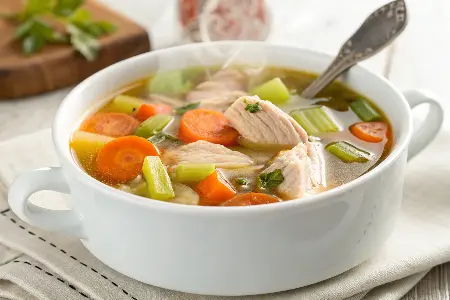
Day 3
Breakfast:
- Green smoothie bowl: Blend 1 cup spinach, 1 banana, ½ cup unsweetened almond milk; pour into bowl and top with 2 tbsp granola and 1 tbsp hemp seeds. (1 cup greens, 1 banana)
Lunch:
- Chicken and vegetable soup: Simmer 4 oz shredded chicken, 1 cup mixed vegetables, and 2 cups low‑sodium broth until tender. (4 oz chicken, 1 cup vegetables, 2 cups broth)
Dinner:
- Baked cod with steamed artichokes & wild rice: Bake 4 oz cod; steam 1 cup artichoke hearts; serve with ½ cup wild rice. (4 oz cod, 1 cup artichokes, ½ cup rice)
Snacks:
- Edamame pods: Steam 1 cup edamame; sprinkle sea salt.
- Celery sticks with hummus: 1 cup celery sticks dipped in 2 tbsp hummus.
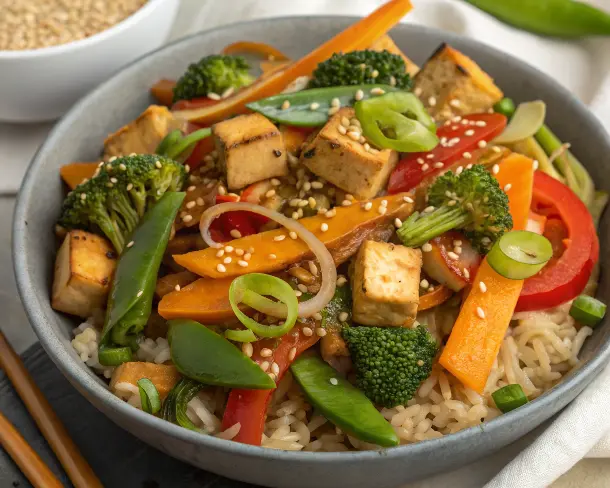
Day 4
Breakfast:
- Barley breakfast bowl with apple & cinnamon: Cook ½ cup pearl barley in water; top with ½ cup diced apple, a dash of cinnamon, and 1 tbsp chopped almonds. (½ cup barley, ½ cup apple)
Lunch:
- Greek farro salad: Mix ½ cup cooked farro, ¼ cup feta, ½ cup cucumber, ½ cup cherry tomatoes, 1 tbsp olive oil, oregano. (½ cup farro, veggies)
Dinner:
- Tofu & broccoli stir‑fry with brown rice: Sauté 4 oz tofu and 1 cup broccoli in 1 tbsp sesame oil; serve over ½ cup brown rice. (4 oz tofu, 1 cup broccoli, ½ cup rice)
Snacks:
- Mixed berries with pistachios: ½ cup mixed berries and 1 oz pistachios.
- Cucumber slices with cottage cheese: 1 cup cucumber topped with ¼ cup cottage cheese.

Day 5
Breakfast:
- Whole grain waffle with peanut butter & strawberries: Toast 1 waffle; spread 1 tbsp peanut butter; top with ½ cup sliced strawberries. (1 waffle, 1 tbsp PB)
Lunch:
- Grilled salmon with sautéed kale: Grill 4 oz salmon; sauté 2 cups kale in 1 tsp olive oil until wilted. (4 oz salmon, 2 cups kale, 1 tsp olive oil)
Dinner:
- Chicken & barley soup: Simmer 4 oz shredded chicken, ½ cup barley, 1 cup mixed vegetables in broth. (4 oz chicken, ½ cup barley)
Snacks:
- Orange with almonds: 1 medium orange and 1 oz almonds.
- Broccoli florets with guacamole: 1 cup broccoli with 2 tbsp guacamole.
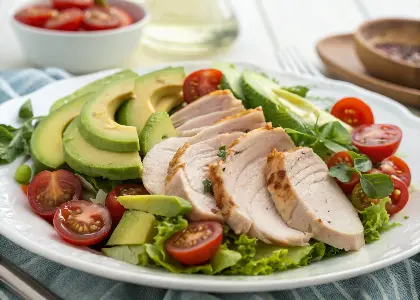
Day 6
Breakfast:
- High‑fiber cereal with milk & raspberries: 1 cup high‑fiber cereal, 1 cup low‑fat milk, topped with ½ cup raspberries. (cereal, milk, berries)
Lunch:
- Turkey and avocado salad: Toss 3 oz sliced turkey, ¼ avocado, 2 cups mixed greens, ½ cup cherry tomatoes, and 1 tbsp olive oil–lemon dressing. (3 oz turkey, ¼ avocado, 2 cups greens, ½ cup tomatoes, 1 tbsp oil)
Dinner:
- Grilled turkey burger with quinoa tabbouleh: Grill 4 oz turkey patty; serve with ½ cup quinoa tabbouleh (quinoa, parsley, tomato, cucumber). (4 oz turkey, ½ cup tabbouleh)
Snacks:
- Homemade trail mix: 1 tbsp each pumpkin seeds, sunflower seeds, dried cranberries.
- Greek yogurt with ground flaxseed: ½ cup yogurt mixed with 1 tbsp flaxseed.
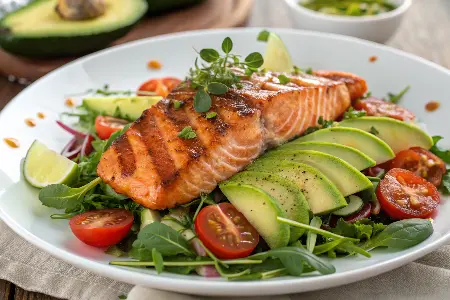
Day 7
Breakfast:
- Quinoa porridge with dates & walnuts: Cook ½ cup quinoa in 1 cup almond milk; stir in 3 chopped dates and 1 oz chopped walnuts. (½ cup quinoa, dates, nuts)
Lunch:
- Grilled Salmon Salad: Grill 4 oz salmon, flake over 2 cups mixed greens, ½ cup cherry tomatoes, ½ cup cucumber; drizzle 1 tbsp olive oil–lemon dressing. (4 oz salmon, mixed greens, 1 avocado)
Dinner:
- Shrimp & vegetable kebabs with bulgur: Skewer 4 oz shrimp, cherry tomatoes, zucchini; grill and serve with ½ cup cooked bulgur. (4 oz shrimp, veggies, ½ cup bulgur)
Snacks:
- Strawberries & almonds: 1 cup strawberries with 1 oz almonds.
- Roasted chickpeas: Roast ½ cup chickpeas with paprika and olive oil.
Foods to Lower Triglycerides
To craft the best diet to lower triglycerides, we’ll focus on foods rich in omega-3 fatty acids, fiber, and healthy fats.
Here’s a list of foods to lower triglycerides that we’ll incorporate into our diet to lower triglycerides:
1. Omega-3 Rich Foods
- Fatty Fish: Salmon, mackerel, sardines, trout, and albacore tuna
- Flaxseeds: Ground flaxseeds or flaxseed oil
- Chia Seeds: Rich in omega-3s
- Walnuts: A good plant-based source of omega-3s
2. Whole Grains
- Oats: Oatmeal and oat bran
- Brown Rice: A whole grain alternative to white rice
- Quinoa: A high-protein whole grain
- Barley: High in soluble fiber
3. Fruits and Vegetables
- Leafy Greens: Spinach, kale, and Swiss chard
- Berries: Blueberries, strawberries, and raspberries
- Citrus Fruits: Oranges, grapefruits, and lemons
- Avocados: High in monounsaturated fats and fiber
- Tomatoes: Rich in antioxidants and fiber
4. Lean Proteins
- Skinless Poultry: Chicken and turkey breast
- Legumes: Lentils, chickpeas, and beans
- Tofu: A plant-based protein option
- Egg Whites: Lower in fat and cholesterol compared to whole eggs
5. Healthy Fats
- Olive Oil: Rich in monounsaturated fats
- Nuts and Seeds: Almonds, sunflower seeds, and pumpkin seeds
- Nut Butters: Almond butter, peanut butter (unsweetened)
6. Fiber-Rich Foods
- Beans and Lentils: Excellent sources of soluble fiber
- Whole Grain Pasta: Look for whole grain versions
- Sweet Potatoes: High in fiber and vitamins
7. Lean Meats and Seafood
- Lean Cuts of Meat: Such as sirloin, tenderloin, and flank steak
- Shellfish: Such as shrimp and crab (in moderation)
8. Non-Dairy Alternatives
- Almond Milk: Unsweetened versions
- Soy Milk: Fortified with calcium and vitamin D
9. Herbs and Spices
- Garlic: Can help reduce cholesterol and triglyceride levels
- Turmeric: Contains curcumin, which has anti-inflammatory properties
- Ginger: Known for its anti-inflammatory effects
10. Beverages
- Green Tea: Contains antioxidants that can help lower triglycerides
- Water: Staying hydrated is crucial for overall health
Foods to Avoid with High Triglycerides
To lower triglycerides, it’s important to avoid these foods that can contribute to high levels:
Here’s a list of foods to avoid:
1. Sugary Foods and Beverages
- Sugary Drinks: Soda, sweetened juices, energy drinks, and sugary coffee beverages
- Candies and Sweets: Candy bars, chocolate, and sugary desserts
- Pastries and Baked Goods: Donuts, cakes, and cookies made with refined sugars
2. Refined Carbohydrates
- White Bread: Made from refined flour
- Regular Pasta: Traditional pasta made from refined wheat
- White Rice: Lacks fiber and nutrients compared to brown rice
- Cereals: High-sugar or low-fiber breakfast cereals
Saturated and Trans Fats
- Fried Foods: French fries, fried chicken, and other deep-fried items
- Fast Food: Burgers, fries, and other high-fat fast food options
- Processed Snacks: Potato chips, crackers, and microwave popcorn with partially hydrogenated oils
- Fatty Cuts of Meat: Ribeye steak, bacon, and other high-fat meats
- High-Fat Dairy Products: Whole milk, cream, butter, and cheese made from full-fat milk
3. Highly Processed Foods
- Processed Meats: Sausages, hot dogs, and deli meats with high sodium and fat content
- Packaged Foods: Meals and snacks with high levels of added sugars and unhealthy fats
4. Alcohol
- Excessive Alcohol Consumption: High intake of alcohol can lead to elevated triglyceride levels. Limit alcohol to moderate levels or avoid it if possible.
5. High-Sodium Foods
- Salty Snacks: Potato chips, pretzels, and salted nuts
- Canned Soups: Often high in sodium and preservatives
- Processed Foods: Foods with added salt and preservatives
6. Foods with Hidden Sugars
- Flavored Yogurts: Often contain added sugars
- Granola Bars: May have high sugar content
- Sauces and Dressings: Some sauces and dressings contain added sugars and unhealthy fats
7. High-Fructose Corn Syrup
- Sweetened Foods: Products containing high-fructose corn syrup, such as some sodas and snack foods
How to Lower Triglycerides Naturally
Here are the key principles of a triglycerides lowering diet:
1. Limit added sugars and refined carbohydrates
- Foods high in sugar such as sodas, sweets, sweetened yogurts, and refined starches like white bread, pasta, crackers, potatoes, and white rice convert rapidly to triglycerides in the blood.
- Aim to keep added sugars under 6 tsp/day for women and 9 tsp/day for men, and choose unrefined, whole‑grain options instead.
2. Reduce saturated and trans fats
- Saturated fats (found in fatty cuts of meat, butter, full‑fat dairy) and trans fats (in partially hydrogenated oils, many processed baked goods) raise TGs and LDL (“bad”) cholesterol.
- The American Heart Association recommends limiting saturated fat to <6% of total calories and avoiding trans fats altogether.
3. Emphasize unsaturated fats & omega‑3s
- Replace saturated fats with monounsaturated and polyunsaturated fats such as olive oil, nuts, seeds, avocado.
- Additionally, eat oily fish (salmon, mackerel, sardines) 2–3 times per week to supply EPA and DHA, which can lower triglycerides by up to 20–30% when consumed regularly.
4. Boost fiber intake
- Soluble fiber (oats, beans, lentils, barley, fruits, vegetables) slows carbohydrate absorption and reduces TG synthesis. Aim for ≥25 g fiber/day, with at least half from whole grains and pulses.
5. Limit or avoid alcohol
- Even moderate alcohol intake can significantly raise triglyceride levels, best to abstain or keep to very small amounts.
6. Manage calories and weight
- Excess body fat contributes to high triglycerides. A modest weight loss of 5–10% can reduce triglycerides by 20% or more. Pair dietary changes with regular physical activity (≥150 min/week) for optimal effect.
Conclusion
Following this 7-day diet to lower triglycerides will not only help you reduce your triglyceride levels but also improve your overall heart health.
By focusing on nutrient-rich foods that naturally lower triglycerides, you’re not just addressing a single health issue but enhancing your overall well-being.
This 7-day diet to lower triglycerides is designed to be sustainable, encouraging you to embrace whole foods and balanced meals that nourish your body and mind.
Remember, consistency is key, and pairing this diet with regular exercise and healthy lifestyle choices will yield the best results.
- 7 day anti inflammatory diet
- 7-day thyroid diet plan for Hashimoto’s disease
- Healthy Blue Zone diet recipes
- 21 day fix eating meal plan
- 7 day clean eating meal plan for beginners
- 3 day military diet plan
- Foods good for endomorphs
- 7 day alkaline diet meal plan
- Weekly real food diet for family
- 7 day low glycemic index meals
- Carnivore diet for beginners
- 7-Day Oatmeal Diet Plan To Lose Up 10 Pounds in a Week
- 7-day protein diet plan for weight loss
- 2-week no sugar meal plan
FAQs
Is rice bad for triglycerides?
Rice, especially white rice is high in refined carbohydrates, which may increase triglyceride levels if consumed in excess. Opt for whole grains like brown rice or quinoa instead.
Can triglycerides be reduced in a week?
Yes, triglycerides can be reduced in a week with a strict diet, regular exercise, and lifestyle changes, but significant reductions typically take longer. Following a diet to lower triglycerides can help you see improvements quickly.
Is chicken OK for triglycerides?
Yes, lean chicken (without skin) is is low in saturated fat and can be part of a diet to lower triglycerides when prepared healthily, such as grilled or baked.
What are four signs of high triglycerides?
Common signs of high triglycerides include xanthomas (fat deposits under the skin), pancreatitis, fatty liver disease, and an increased risk of heart disease. Often, high triglycerides have no symptoms and are detected through blood tests.
What is the best herbal medicine for high triglycerides?
Garlic is considered one of the best herbal medicines for lowering triglycerides. Studies have shown that garlic supplements can help lower triglycerides and improve cardiovascular health.
Is papaya good for triglycerides?
Yes, papaya is low in fat and calories and high in fiber, making it a good choice for those looking to lower triglycerides.
Disclaimer: This article is intended for informational purposes only and should not be considered medical advice.
Always consult with a healthcare professional or a registered dietitian before making significant changes to your diet, especially if you have underlying health conditions or are taking medications.
